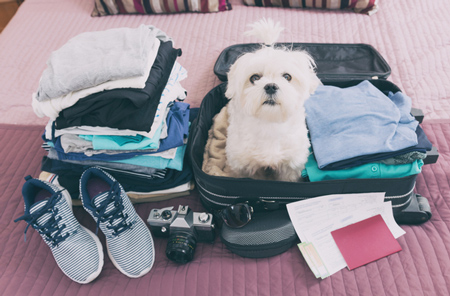Is It Safe to Sedate Your Dog for Travel?

If you're getting ready to head out on a long trip with your dog, you may be wondering if you can sedate him to make it easier on both of you. This question comes up often when people are embarking on a long car trip or taking their dog on an airplane.
Sedation Risks for Dogs
There are several medications, both prescription and over-the-counter, that people sometimes consider giving their dogs for traveling. Most of these medications do not put the dog completely "out," but make them drowsy, uncoordinated, and more docile.
There are some serious risks involved with attempting to sedate your dog for travel, including:
- Many of these medications can alter your dog's heart and breathing rates. This can be dangerous when your dog isn't under a veterinarian's supervision.
- For air travel in particular, there are already stresses on your pet's body from changes in air pressure and temperature. Further adding respiratory and heart rate changes can spell disaster. This is particularly true for very young, old, infirm, or short-nosed dogs.
- Sedatives can cause a dog to have difficulty balancing. This may result in injuries if your dog's crate is being moved and he can't hold himself steady.
Preparing Your Dog for Travel
The best way to ensure that your dog has a good experience traveling is to do what you can to prepare him ahead of time.
If you will be traveling by automobile and your dog is nervous about car rides or gets carsick, take some time to acclimate him to riding before the big trip. You can find specific steps for doing so here: "Traveling With Your Dog," and "Car Sickness in Dogs."
If you will be taking your dog on a plane, be sure to get him used to his travel crate well ahead of time. Allow him to spend some time in there with the door open first, giving him praise and treats when he stays inside. Outfit the crate with his favorite bed and some toys, so he'll feel more comfortable. You can also spray the inside of the crate with DAP, a synthetic version of a dog-calming pheromone, or Rescue Remedy before he gets in, to create a peaceful space.
Be sure to determine what your dog will need before traveling. In many cases, if you are going by air or to a different state by car, you will need a health certificate signed by a veterinarian within a certain number of days of traveling. Check with your veterinarian to determine what you will need and make an appointment. You don't want to be delayed at the gate in the airport when you don't have the proper paperwork.
Traveling to other countries can come with particularly specific requirements for vaccinations, timing, and sometimes blood tests, so giving yourself plenty of time to prepare is crucial.
If it is at all possible, don't allow your dog to be put in the cargo area of a plane. The temperature variances there can be extreme, and there will be no one to notice if your dog is having a medical problem. Getting lost during loading and unloading is also a possibility. Keep your dog in the cabin with you if possible.
It is best to make sure your dog has emptied his bladder and doesn't have too full of a stomach just prior to traveling by car or plane. Check with your veterinarian to determine what's safe for your particular dog, especially if he has any medical problems, but it may be best to provide a small treat prior to traveling rather than a full meal.
If You Still Feel that Sedation Is Necessary . . .
If you still believe that your dog may need sedation in order to have a safe and comfortable trip, it is imperative that you speak with your veterinarian. He or she knows your individual dog's circumstances and is the best one to decide which medication and how much is the safest for him. The doctor can also discuss with you any specific potential side effects or problems associated with that drug so you will be as informed as possible.
You can check this helpful page provided by the American Veterinary Medical Association for more tips on traveling safely with your dog: https://www.avma.org/public/PetCare/Pages/Traveling-with-Your-Pet-FAQs.aspx
You May Also Like These Articles:
How to Manage Your Dog's Over-The-Top Greetings
How Do You Stop a Dog from Barking?
Notice: Ask-a-Vet is an affiliated service for those who wish to speak with a veterinary professional about their pet's specific condition. Initially, a bot will ask questions to determine the general nature of your concern. Then, you will be transferred to a human. There is a charge for the service if you choose to connect to a veterinarian. Ask-a-Vet is not manned by the staff or owners of DogHealth.com, and the advice given should not delay or replace a visit to your veterinarian.


